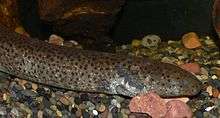Lesser siren
| Lesser siren | |
|---|---|
 | |
| Scientific classification | |
| Kingdom: | Animalia |
| Phylum: | Chordata |
| Class: | Amphibia |
| Subclass: | Lissamphibia |
| Order: | Caudata |
| Family: | Sirenidae |
| Genus: | Siren |
| Species: | S. intermedia |
| Binomial name | |
| Siren intermedia Barnes, 1826, | |
The lesser siren (Siren intermedia) is a species of aquatic salamander native to the eastern United States and northern Mexico. They are referred to by numerous common names, including two-legged eel, dwarf siren, and mud eel. The specific epithet intermedia denotes their intermediate size, between the greater siren, Siren lacertina, and the dwarf sirens, Pseudobranchus spp.
Behavior
The lesser siren is nocturnal, spending its days hidden in the debris and mud at the bottom of slow-moving bodies of water. They feed primarily on aquatic invertebrates, including various kinds of worms, snails, and crustaceans. They will also eat the tadpoles and eggs of other amphibians.
Reproduction occurs in the spring, with eggs being laid in shallow depressions at the bottom of calm areas of water, usually surrounded by vegetation. Though little is known about their courtship, it is believed to be quite violent, as many specimens collected have scarring from healed bite marks from other sirens. About 12-300 eggs are laid at a time, and several clutches may be laid over the course of the year. Hatchlings are only about 0.4 in (1.1 cm) in length, but grow quickly. Maturity is reached in three to four years.
The lesser siren is vocal, unlike most salamanders, and will emit a series of clicks when it approaches others of its species, or a short screeching sound if handled.
If the habitat dries up during the summer, lesser sirens are capable of excreting a substance from their skin which protects them from dehydrating, and enables them to stay buried in dry mud for months until the water returns. Their small legs enable them to move on dry land for short periods of time.
Geographic distribution
The lesser siren is found in the United States, primarily from Virginia to Florida, and west to Texas (ranging into northeastern Mexico as far as Veracruz), and north to Illinois, Indiana and Michigan.
Taxonomy
Sources disagree on the number of subspecies within S. intermedia; most agree there are at least two, an eastern and a western variety. Many sources also include a third subspecies, the Rio Grande lesser siren, S. i. texana, but researchers disagree whether the Rio Grande variety belongs as a lesser siren, within S. intermedia, or as a greater siren, within S. lacertina, and some others even consider it to be its own species, as S. texana.
- Eastern lesser siren, S. i. intermedia (Goin, 1942)
- Western lesser siren, S. i. nettingi (Goin, 1942)
- Rio Grande lesser siren, S. i. texana (Goin, 1957)
Conservation status
The lesser siren is quite common through most of its range, but rarely seen due to its secretive nature. Like almost all species of amphibian, their numbers are believed to be declining due to general reductions in water quality caused by agricultural pesticide and fertilizer runoff. They are frequently collected and used as bait for fishing. The species is believed to be extirpated from Michigan, and the S. i. texana subspecies is listed as a threatened species in Texas.
References
- ↑ Parra-Olea, G.; Wake, D.; Hammerson, G.A. (2008). "Siren intermedia". IUCN Red List of Threatened Species. Version 2014.3. International Union for Conservation of Nature. Retrieved 2015-01-16.
- Animal Diversity Web: Siren intermedia
- INHS Reptile & Amphibian Collection: Siren intermedia - Lesser Siren
| Wikispecies has information related to: Siren intermedia |
